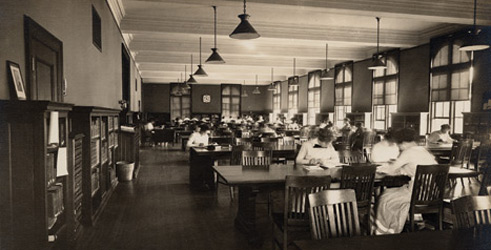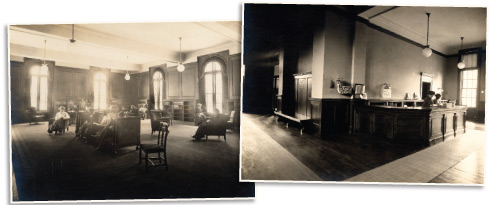If These Walls Could Talk, They'd Speak Volumes
By Jan McCoy Ebbets

It wasn't long after Smith's new library opened that students were making good use of the study tables in the Seelye Reading Room, now the Mair Reference Room. Photo from Smith College Archives.
In 1909 there were many "firsts." Orville Wright test–flew the first U.S. Army Air Corps plane for one hour and 12 minutes, Calvin Coolidge was elected to his first term as mayor of Northampton, Massachusetts, and nearby Smith College opened its first academic library.
"Our new library is finished and in use. You should see it!" wrote Marjorie Browning, class of 1910, in a December 1909 letter to her boyfriend. "It is a magnificent substantial building, very artistically finished in brown mission style within. There is so much room in it that we were lost for several days. One room, which is not ready yet, is the 'browsing–room.' As the name suggests, it is to contain well–bound interesting books to be read in front of the open–fire or on the comfortable window–seats or cozy chairs about the room."
At the heart of the excitement was the fact that Smith had lacked a library of its own since opening in 1875. Then, Smith's "library" was referred to as a "reading room" and housed in College Hall; its collection consisted of one Webster's Dictionary and two newspapers to which the college subscribed. When students needed reference books they used the City Library, then Forbes Library and finally in 1900, a room in Seelye Hall when the college's book collection had grown enough to merit several dedicated open stacks.
But students still complained. Demand was high and space to study was lacking; Smith women joked about battling over the occasional empty chair and the limited copies of reference works.
Finally, with a $75,000 gift from Andrew Carnegie—which amounts to more than $1.75 million in today's dollars—construction for Smith's first academic library began in the summer of 1908. Smith alumnae and friends pledged matching gifts to raise the remainder of the $164,000 cost. To develop plans for the building, the college commissioned New York architects James Hewlett and Austin Lord—who worked in the offices of McKim, Mead and White when the firm designed the Boston Public Library in 1888.
When the Smith library opened for business during Thanksgiving week in 1909, some 30,000 volumes were proudly unpacked and shelved in the new building.
"The first transfer of books from the old library in Seelye Hall was begun on Monday morning, November 22 [1909]," reported Florence Homer Snow, Smith class of 1904, who was the first general secretary of the Alumnae Association, in a January 1910 article in the Smith Alumnae Quarterly. "The moving was completed Saturday, and Monday, November 29, the doors were opened to the college. Painters and carpenters were still in the building, but, as the President said in chapel, the only way to drive them out was for the college to move in."

LEFT: The Neilson Browsing Room, as seen circa 1910–15, was said to be the first leisure reading room in a United States college library. RIGHT: In 1909, as it is today, Neilson's circulation desk was centrally located. Students lauded the library for its open and inviting interior, enhanced by rich woodwork and modern lighting. Photos from Smith College Archives.
To the excited Smith community, the new library seemed spacious and luxurious. "They were especially proud of their new library and grateful for it," wrote Smith English literature professor Mary Ellen Chase in a 1956 article for the Smith Alumnae Quarterly. They marveled over the handsome interior, its dark rich woodwork, good lighting, and balconies and lanterns of wrought iron. There were comfortable reading rooms located on all three levels, large windows that allowed light to pour through and long spacious tables. A grand staircase opposite the circulation desk gave passage to the upper floors.
In spite of the excitement, the opening brought attention to the fact that the college's 30,000 volumes filled only three tiers of stacks. So the call went out for gifts and donations to fill the empty shelves, and alumnae started sending books—reference works as well as novels, and bound collections of popular magazines. Among those that arrived in 1909 were 1,563 volumes of limited edition works by then–standard authors from Lucie Tower Chandler, class of 1905. Those books eventually formed the nucleus of the book collection of the Browsing Room.
The deluge of books continued. According to a report prepared by Josephine Clark, the first librarian, some 5,900 books were added to the library collection between May 1909 and May 1910; more than 2,900 were gifts. This increase, she noted, "is striking evidence of the effect of the new building upon many who are ready to contribute to the efficiency of the library as an important factor in college work."
The college work continues, and 2009 marks the 100th anniversary of the building, which had been called just "The Library" until 1946 when it was renamed for Smith's third president William Allan Nielson.
But now, long gone are the days of the quiet rarefied world of the college library where librarians occupied themselves dispensing guidance, shelving books and shushing patrons.
"It's a stereotype we still suffer from," notes Director of Libraries Christopher Loring. "But it's not what we're about anymore." In a time of accelerated technological change, the Smith libraries (the flagship Neilson, its three branch libraries and three special collections) like most liberal arts college libraries—are transforming and adapting, and the reference librarians are revising their roles. The digital age and new information technologies have changed not only the ways students and scholars conduct research and libraries deliver services but also how information is collected, preserved and organized.
"Study in the library or lounges. The lights are already on there all day," suggests a small flyer distributed campuswide by the college, reminding the community of the simple ways to conserve energy in places where people live, work and study.
Much has been done in the past three years to adapt Neilson Library to the needs of college students, faculty and staff in an ever–changing teaching and learning environment.
Today, Neilson is a sprawling building, the original structure added to at intervals over the years, with elevated walkways at both ends to Wright Hall and the Alumnae Gymnasium. Its first floor is now full of brightly lit public spaces, much of the glow coming from glimmering computer screens and LED indicators. The Mair Reference Room (once known as the Seelye Reading Room) has been expanded into an Information Commons that spills over into several other spaces on Neilson's main floor.
On a recent weekday around lunchtime, natural light streams through the tall arched windows of the Information Commons. Students cluster around group workstations, chatter and discuss assignments; others do solo work at computer terminals or lounge with friends and read side by side in brightly colored armchairs. There is a constant audible buzz of conversation.
Here students can use a variety of computers, printers and special software to do anything from touching up photos to editing audio files and creating Web pages. Reference librarians are on hand to offer guidance for all this technology.
Another popular new space, dubbed The Studio, has been equipped with white boards and multimedia and plasma screens, and best of all, moveable furniture that can be reconfigured to accommodate students who want to work together in groups.
Wireless access is now available throughout the library, and such spaces as the third–floor Collacott Periodicals Room have been updated. There, new outlets for laptops and 74 new oak chairs for comfortable seating have been added. And a big favorite for many who frequent the library on cold winter nights is the working gas fireplace.
On the second floor, the newly created Quantitative Learning Center is another service innovation offered by the college. The QLC is part of the growing web of academic support for students. Similar to the college's Jacobson Center for Writing, Teaching and Learning, the QLC offers peer and expert tutoring, workshops and class study sessions to students doing quantitative work across the curriculum. (See www.smith.edu/qlc for more information.)
"It made perfect sense to locate the Quantitative Center in Neilson," notes Loring. "It is part of our vision that libraries be vital learning places, not simply warehouses for books."
Likewise, another learning place is located on the library's third floor: the Louise W. and Edmund J. Kahn Liberal Arts Institute, which fosters collaborative research among Smith College faculty, students and visiting scholars. Each year the institute supports long–term and short–term projects proposed, planned and organized by members of the Smith College faculty.
Brick by brick, book by book, Neilson Library has undergone five major renovations and additions since 1909, including a heating and ventilation system upgrade to provide a better environment for the library's books and accommodate new demands on physical spaces. It's grown from the original H shape, designed to house books and give students quiet rooms to study, to something very different: an institution with an ever–morphing role as a learning center that must exist both within and beyond the library walls. While continuing to offer strong on–site collections, the library offers an expanding array of digital resources with the professional expertise to teach and guide library users.
Smith still has visions for its grand library.
One of those is to make public spaces within Neilson physically more attractive and appealing to students, to make the library a place where students like to come to study. Currently the college is raising funds to create a new Reading Room at the entrance of Neilson, just across the foyer from the Browsing Room.
In addition, discussions are ongoing about whether there might be a suitable space in Neilson to incorporate a café or bookstore–style coffee bar in the building, as libraries at colleges such as Mount Holyoke and Vassar have done. And while it has been decided that Neilson is too difficult a building to staff efficiently 24 hours a day, the library now keeps its doors open nearly 18 hours a day Sunday through Thursday, closing earlier on Friday and Saturday nights, during the academic year.
"We're redefining what it means to be a library today," says Loring. "How are our collections going to change? How do we deliver our services to users in new ways? We must integrate new and changing technologies in everything we do. The very nature of our work as librarians must change."
Loring points to the tensions that exist as libraries extend themselves in two different directions, the physical and the virtual. "Paradoxically, in this age of networked information, the library as a physical space is more important than ever. That is why we continue to work to create inspiring environments within those spaces for study, learning, interaction and discovery."
What he envisions may already be a reality to many, according to a recent informal e–mail survey of Smith students.
"I think that the library is a comforting place on campus for many Smith students," notes Erin King '11, who also works at the library's circulation desk. "The librarians are friendly, knowledgeable and eager to help. And the building has many endearing quirks."
"I use the library about three times a week. Sometimes I feel like I live there," says government major Ellen Daoust '09. "At this point Nielson is a place of comfort for me."
Daoust says she spends most study time on Neilson's first floor, usually in its well–equipped computer lab. But, as a senior, she has some regrets. "I have come to the realization that I will never fully use all of the resources that the library offers. They have such an enormous amount of material to help you there."
Contributing to this article were Leslie Fields, records services archivist; Mary Irwin, gifts and development officer, Friends of the Libraries; and Carole Fuller, director of strategic marketing, Office of College Relations.
|























